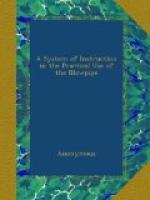Should the above reactions not be readily discerned, it should not be considered as an indication that the substances are not present, for they are frequently expelled in such combinations that the above reactions will not take place. This is often the case with sulphur, selenium, arsenic, and tellurium. It frequently happens, likewise, that these substances are in such combinations that heat alone will not sublime them; or else two or more of them may arise together, and thus complicate the sublimate, so that the eye cannot readily detect either substance. Sometimes sulphur and arsenic will coat the tube with a metal-like appearance, which is deceptive. This coating presents a metallic lustre at its lower portion, but changing, as it progresses upward, to a dark brown, light brown, orange or yellow; this sublimate being due to combinations of arsenic and sulphur, which compounds are volatilized at a lower temperature than metallic arsenic.
If certain reagents are mixed with many substances, changes are effected which would not ensue with heat alone. Formiate of soda possesses the property of readily reducing metallic oxides. When this salt is heated, it gives off a quantity of carbonic oxide gas. This gas, when in the presence of a metallic oxide, easily reduces the metal, by withdrawing its oxygen from it, and being changed into carbonic oxide. If a little fly-stone is mixed with some formiate of soda, and heated in the bulb, the arsenic is reduced, volatilized, and condenses in the cool portion of the tube. By this method, the smallest portion of a grain of the arsenical compound may be thus examined with the greatest readiness. If the residue is now washed, by which the soda is got rid of, the metallic arsenic may be obtained in small spangles. If the compound examined be the sulphide of antimony, the one-thousandth part can be readily detected, and hence this method is admirably adapted to the examination of medicinal antimonial compounds. The arsenites of silver and copper are reduced by the formiate of soda to their metals, mixed with metallic arsenic. The mercurial salts are all reduced with the metal plainly visible as a bright silvery ring on the cool portion of the tube. The chloride and nitrate of silver are completely reduced, and may be obtained after working out the soda, as bright metallic spangles. The salts of antimony and zinc are thus reduced; also the sulphate of cadmium. The sublimate of the latter, although in appearance not unlike that of arsenic, can easily be distinguished by its brighter color. It is, in fact, the rich yellow of this sublimate which has led artists to adopt it as one of their most valued pigments.
2. EXAMINATIONS IN THE OPEN TUBE.




